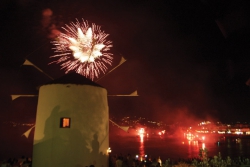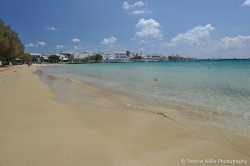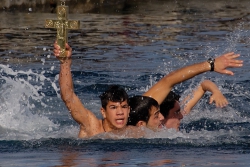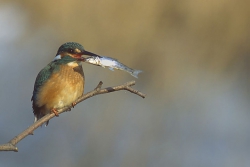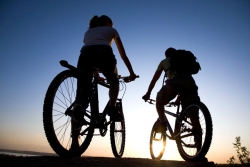Parikia-Marathi-Kostos-Pigados-Lefkes-Prodromos-Marpissa-Piso Livadi
This mountain route crosses over the highest mountain of Paros and through the marble quarries and arrives at one of the more touristy areas of the island. The highlight of the excursion is the opportunity to visit inland regions, which still maintain Aegean architectural elements as well as gorgeous views of the coast and villages of the island.
We head eastwards for the first few kilometers, on a gentle ascent through the last houses of Parikia. As we climb, the landscape becomes bushy, with few crops. Marathi is the first village on the route, a small settlement with characteristically Aegean houses and rooms for rent. The first point of interest is the places where one can first see the ancient marble quarries in the hollows of the rocks just above Marathi. A modern path has been built which guides visitors to the ancient quarries. The modern aspect of this ancient art of marble extraction is discovered a few hundred meters higher at the peak of the mountain, where operational quarries continue to extract the world-famous marble of Paros.
Circling the quarry, we take the downhill road that leads to the sea and stop for a coffee in the square at the small village of Kostos, where we can walk along the quaint streets and see old Aegean churches (such as Agios Panteleimonas, patron saint of the village, Agia Marina and Anastasi), as well as the monument dedicated to the great teacher Athanasios the Parian, who was born in the village and resided there in the 18th century. His home in the village has been preserved and is open to the public. The old wash houses, which were recently restored, can be found on the outskirts of the village.
When visiting Kostos in the summer months, visitors can enjoy one of the three festivals hosted in the village: 24 June in memory of Athanasios the Parian, 17 July (Agia Marina), and 27 June (Agios Panteleleimonas).
The landscape has changed greatly over the years and the rock and bushes have given way to vineyards and other small crops. The view to the north and east seems endless. We continue south towards Lefkes, the next point of interest on our tour of the east coast. Lefkes is one of the largest inland villages and is the settlement at the highest altitude. To the right of the village towers a pine tree covered mountain slope, more proof of the diverse vegetation found on the island.
On the final stretch towards Lefkes, visitors will catch their first glimpse of a traditional Cycladic settlement, tempting them to walk its narrow streets, which stretch amphitheatrically up another hill on the southwest side of the village. Walking along Ramnos, the main street of the village, we can see many neoclassical buildings, the school, the House of Literature and the Museum of Cycladic Folklore as well as many tourist shops.
The sea is visible as we walk down the main cobblestone alleyway, through the wide gorge that begins at Lefkes and ends in the farmlands in the northeast of the island. Be sure to have a drink on the main square next to the War monument honoring fallen heroes. Ramnos leads to the church of Agia Triada at the end of the village, known for its distinctive architecture and the Parian marble used to build it.
It quickly becomes apparent that Lefkes isn't a typical run-of-the-mill village and was fully justified to be the first capital of Paros. All houses in the village are clean, whitewashed and overflowing with brightly colored flowers, season permitting. If you visit the village in late August, be sure to attend the feast of Karavolas, one of the largest festivals in the Aegean, with plenty of food (and the large snails known as karavoles), wine, music and dancing till dawn.
Before leaving Lefkes, consider visiting the other religious monuments in the village and the vicinity, including the church of Panagia of Ipapanti or "Virgin Mary of the Cells" as the locals call it, the monastery of Agios Ioannis of Prodromos, the monastery of Agia Kyriaki and many other smaller country chapels.
Hiking enthusiasts will enjoy the Byzantine road, a unique marble-paved path over 1,000 years old that runs parallel to the automobile road and connects Lefkes with the village of Prodromos. It is 3.5 kilometers long, easy to walk and offers wonderful views of the sea.
Whether visited by car or on foot, Prodromos is one of the last stops on our excursion through the mountain villages of the islands. Another picturesque village perched on a hill, which took its name from the Temple of Agios Ioannis of Prodromos, which was built 60 years ago in the village. Park the car and walk through the bell tower arch that links the two churches, Agios Spyridonas and Agios Nikolaos, and is the gateway to the village. The walk through the village with beautiful houses and traditional cafés is delightful. Traditional windmills can be found on the outskirts of Prodromos, some of which have been renovated and are inhabited.
Another Parian festival awaits visitors to the village on 23 June, the feast of Agios Ioannis of Prodromos.
On reaching Prodromos, the mountains of Paros are behind us and we are faced with a view of the cultivated valley hovering over beautiful beaches like Molos, Kalogeros and Tsoukalia. Pick one for a quick, cool swim in summer months.
The next village is Marpissa, located just 2 kilometers from the sea and its port, Piso Livadi. Marpissa is one of the tourist villages on Paros and stands out for both the quaintness of its old Aegean houses and the nightlife it offers in the summer at the taverns and bars in Piso Livadi. Built amphitheatrically on a low hill, it tempts visitors to walk along its narrow cobblestone streets and visit the Nikos Perantinos Sculpture Museum, the large byzantine church of Metamorphosis and the monument dedicated to Nikolas Stellas, a young man hung by the Germans on 22 May 1944 at the age of 23.
One of the most characteristic areas of Marpissa and Paros in general, is the square with 4 windmills. The square is the start of a path that leads to the monastery of Agios Antonios. The monastery is built on a hill that blooms with greenery in the spring, called Kefalos, with a spectacular view of the sea, nearby beaches, islands (Irakleia, Naxos) and inland Paros. It is well worth a visit, even by car. Few people are aware that Kefalos Hill is, in reality, an old extinct volcano. This same hill was once the site of a Venetian castle built by Sommaripa, the overlord of Paros. It was destroyed in an attack by the pirate Barbarossa after being seized in 1537. Visitors to Marpissa at Easter will experience the sacred devoutness of the village during the representation of the Passions on Good Friday and the Easter feast.
With a short detour back to Marpissa, we can visit the nearby village of Marmara, named for the marble pieces found there, which were used to build the houses. The windmill, the old mansions, the Temple of Taxiarhis and the Church of Theotokou, with three distinct bell towers, are well worth visiting. With Marmari as a starting point, there are several lovely beaches on the eastern coast of the island, including Molos, Tsoukalia and many others.
Piso Livadi is the port of Marpissa and the final destination of our excursion. The village is a short two-kilometer drive from Marpissa, through two small pine forests. We pass by some prickly pear trees and the village with its small port lies ahead (with some small boats that make trips to nearby islands). Next to the port with its taverns and bars is the beach of Logaras, with golden sand and, at its top end, natural shade under the sea pines for early visitors. If you are still in the mood to see more, visit the church of Agios Georgios Thalassitis and admire the old holy paintings.
We head eastwards for the first few kilometers, on a gentle ascent through the last houses of Parikia. As we climb, the landscape becomes bushy, with few crops. Marathi is the first village on the route, a small settlement with characteristically Aegean houses and rooms for rent. The first point of interest is the places where one can first see the ancient marble quarries in the hollows of the rocks just above Marathi. A modern path has been built which guides visitors to the ancient quarries. The modern aspect of this ancient art of marble extraction is discovered a few hundred meters higher at the peak of the mountain, where operational quarries continue to extract the world-famous marble of Paros.
Circling the quarry, we take the downhill road that leads to the sea and stop for a coffee in the square at the small village of Kostos, where we can walk along the quaint streets and see old Aegean churches (such as Agios Panteleimonas, patron saint of the village, Agia Marina and Anastasi), as well as the monument dedicated to the great teacher Athanasios the Parian, who was born in the village and resided there in the 18th century. His home in the village has been preserved and is open to the public. The old wash houses, which were recently restored, can be found on the outskirts of the village.
When visiting Kostos in the summer months, visitors can enjoy one of the three festivals hosted in the village: 24 June in memory of Athanasios the Parian, 17 July (Agia Marina), and 27 June (Agios Panteleleimonas).
The landscape has changed greatly over the years and the rock and bushes have given way to vineyards and other small crops. The view to the north and east seems endless. We continue south towards Lefkes, the next point of interest on our tour of the east coast. Lefkes is one of the largest inland villages and is the settlement at the highest altitude. To the right of the village towers a pine tree covered mountain slope, more proof of the diverse vegetation found on the island.
On the final stretch towards Lefkes, visitors will catch their first glimpse of a traditional Cycladic settlement, tempting them to walk its narrow streets, which stretch amphitheatrically up another hill on the southwest side of the village. Walking along Ramnos, the main street of the village, we can see many neoclassical buildings, the school, the House of Literature and the Museum of Cycladic Folklore as well as many tourist shops.
The sea is visible as we walk down the main cobblestone alleyway, through the wide gorge that begins at Lefkes and ends in the farmlands in the northeast of the island. Be sure to have a drink on the main square next to the War monument honoring fallen heroes. Ramnos leads to the church of Agia Triada at the end of the village, known for its distinctive architecture and the Parian marble used to build it.
It quickly becomes apparent that Lefkes isn't a typical run-of-the-mill village and was fully justified to be the first capital of Paros. All houses in the village are clean, whitewashed and overflowing with brightly colored flowers, season permitting. If you visit the village in late August, be sure to attend the feast of Karavolas, one of the largest festivals in the Aegean, with plenty of food (and the large snails known as karavoles), wine, music and dancing till dawn.
Before leaving Lefkes, consider visiting the other religious monuments in the village and the vicinity, including the church of Panagia of Ipapanti or "Virgin Mary of the Cells" as the locals call it, the monastery of Agios Ioannis of Prodromos, the monastery of Agia Kyriaki and many other smaller country chapels.
Hiking enthusiasts will enjoy the Byzantine road, a unique marble-paved path over 1,000 years old that runs parallel to the automobile road and connects Lefkes with the village of Prodromos. It is 3.5 kilometers long, easy to walk and offers wonderful views of the sea.
Whether visited by car or on foot, Prodromos is one of the last stops on our excursion through the mountain villages of the islands. Another picturesque village perched on a hill, which took its name from the Temple of Agios Ioannis of Prodromos, which was built 60 years ago in the village. Park the car and walk through the bell tower arch that links the two churches, Agios Spyridonas and Agios Nikolaos, and is the gateway to the village. The walk through the village with beautiful houses and traditional cafés is delightful. Traditional windmills can be found on the outskirts of Prodromos, some of which have been renovated and are inhabited.
Another Parian festival awaits visitors to the village on 23 June, the feast of Agios Ioannis of Prodromos.
On reaching Prodromos, the mountains of Paros are behind us and we are faced with a view of the cultivated valley hovering over beautiful beaches like Molos, Kalogeros and Tsoukalia. Pick one for a quick, cool swim in summer months.
The next village is Marpissa, located just 2 kilometers from the sea and its port, Piso Livadi. Marpissa is one of the tourist villages on Paros and stands out for both the quaintness of its old Aegean houses and the nightlife it offers in the summer at the taverns and bars in Piso Livadi. Built amphitheatrically on a low hill, it tempts visitors to walk along its narrow cobblestone streets and visit the Nikos Perantinos Sculpture Museum, the large byzantine church of Metamorphosis and the monument dedicated to Nikolas Stellas, a young man hung by the Germans on 22 May 1944 at the age of 23.
One of the most characteristic areas of Marpissa and Paros in general, is the square with 4 windmills. The square is the start of a path that leads to the monastery of Agios Antonios. The monastery is built on a hill that blooms with greenery in the spring, called Kefalos, with a spectacular view of the sea, nearby beaches, islands (Irakleia, Naxos) and inland Paros. It is well worth a visit, even by car. Few people are aware that Kefalos Hill is, in reality, an old extinct volcano. This same hill was once the site of a Venetian castle built by Sommaripa, the overlord of Paros. It was destroyed in an attack by the pirate Barbarossa after being seized in 1537. Visitors to Marpissa at Easter will experience the sacred devoutness of the village during the representation of the Passions on Good Friday and the Easter feast.
With a short detour back to Marpissa, we can visit the nearby village of Marmara, named for the marble pieces found there, which were used to build the houses. The windmill, the old mansions, the Temple of Taxiarhis and the Church of Theotokou, with three distinct bell towers, are well worth visiting. With Marmari as a starting point, there are several lovely beaches on the eastern coast of the island, including Molos, Tsoukalia and many others.
Piso Livadi is the port of Marpissa and the final destination of our excursion. The village is a short two-kilometer drive from Marpissa, through two small pine forests. We pass by some prickly pear trees and the village with its small port lies ahead (with some small boats that make trips to nearby islands). Next to the port with its taverns and bars is the beach of Logaras, with golden sand and, at its top end, natural shade under the sea pines for early visitors. If you are still in the mood to see more, visit the church of Agios Georgios Thalassitis and admire the old holy paintings.









